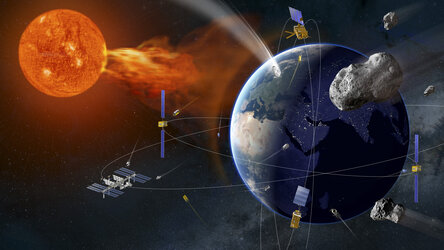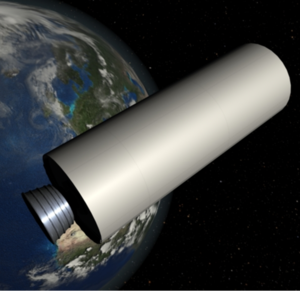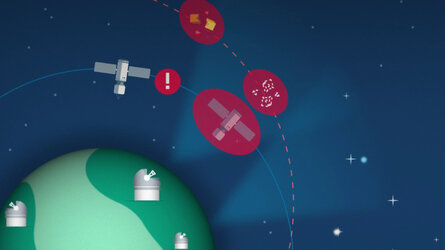ESA & UNOOSA space debris infographics and podcast
Space debris is a topic of global concern. While space has brought huge benefits to individuals and societies across the globe, the rapid increase of launched objects and increased traffic in our space highways means we are creating ever-more debris and threatening the very technologies we have come to rely on.
Acknowledging the significance of this problem, ESA and the United Nations Office for Outer Space Affairs (UNOOSA) have come together to raise awareness with a series of nine infographics and corresponding podcasts that tell the space debris story so far and illustrate some of the solutions available for us to achieve a sustainable use of space.
For more information on the state of our space environment, check out ESA's Space Environment Report 2023.
1. Satellites vs space debris

Satellites in orbit share near-Earth space with millions of fast-moving and dangerous debris objects. From tiny fragments millimetres in size to entire satellites no longer working, no longer controlled, roaming the space highways, each debris piece travels many kilometres per second. Any impact with one of these objects threatens to atleast impair the functioning of a working spacecraft, or at worst destroy it altogether, creating ever more debris.
In this infographic from ESA and UNOOSA, find out about the scale of the debris problem: how much of it is up there, what scales are we talking about, and what are our satellites are up against?
Find out more in Episode one of the corresponding ESA & UN podcast in which Tim Flohrer, Head of ESA's Space Debris Office, and Nathalie Ricard, Scientific Officer at the UNOOSA, discuss the scale of the debris problem, asking what are our satellites are up against?
2. Falling to Earth takes a long time

Our planet's atmosphere gradually slows down satellites in orbit and brings them back down to Earth. This process can be relatively fast for satellites flying at low altitudes, taking less than 25 years, but for satellites launched into orbits tens of thousands of kilometres away, it can be thousands of years before they return, if the atmosphere is able to impact them at all.
Had the dinosaurs launched a satellite into the furthest geostationary orbit, it would still be up there today.
This means that as we launch satellites to space we must consider how they will be removed at the end of their lives, or else the skies will be filled with old, defunct spacecraft at risk of collision, explosion, and the near-certain creation of vast amounts of space debris.
In this infographic from ESA and UNOOSA, find out how long it would take satellites at different altitudes to naturally fall back to Earth, and what must be done responsibly dispose of them at the end of their lives.
Find out more in Episode two of the corresponding ESA-UN podcast, "Falling to Earth takes a long time", in which Francesca Letizia and Xing-Yi Ang discuss the problem of slowly returning satellites, and what needs to be done to responsibly dispose of them at the end of their lives.
3. The cost of avoiding collision

Space might seem an empty, vast expanse, but satellites in Earth's orbit face the constant risk of collision - with other satellites, dead or alive, or with fragments of debris.
It is now routine for operators of spacecraft in busy highways to divert their mission out of harms way. In fact at ESA, each mission flown performs on average free to four 'collision avoidance manoeuvres' per year.
These manoeuvres are costly. Hours are spent on the ground monitoring the skies, calculating the risk and planning manoeuvres, not to mention the extra fuel spent and missed science and data collected while instruments are turned off.
In episode three of the ESA-UNOOSA space debris series, Benjamin Bastida Virgili and Hazuki Mori discuss the cost of collision avoidance, and what can be done.
4. We're launching more than ever

Since the beginning of the space age, with the launch of Sputnik in 1958, we have launched thousands of rockets carrying more than ten thousand satellites into space.
The last few years have seen a dramatic increase in these numbers, and over the last few decades there has been a change in the type of mission flown, with private companies (yellow) launching smaller satellites than those launched by non-commercial agencies (blue).
This graph, created in a joint project between ESA and the UN, also shows the number of unregistered objects (red) has increased in recent years. It should be noted that these are objects not yet registered with the UN, and are expected to rise.
In episode 4 of the ESA-UNOOSA space debris series, Ian Freeman and Francesca Letizia discuss what these changes mean for the future of spaceflight and the creation of space debris.
5. The role of reentries

What goes up, nearly always comes back down. When it comes to the objects we send to space, atmospheric reentries are actually a fundamental tool in minimising the creation of space debris and ensuring a sustainable future in space.
Objects in low-Earth orbit, affected by the 'drag' forces caused by Earth's atmosphere, gradually lower in altitude and then make a rapid and fiery descent towards Earth.
Small objects disintegrate as they reenter due to the immense friction and heat created, but parts of larger bodies can reach the ground so should be controlled to land over uninhabited regions.
Join Stijn Lemmens and Jorge del Rio Vera to find out more about why this matters in the joint ESA-UN podcast that narrates this infographic.
6. Where today's debris came from

The millions of fragments of debris in orbit today are the direct result of 'fragmentation events' in the past. Of the nearly 650 events known to date, those caused by propulsion have created the greatest amount of space debris.
Energy left undisposed of on-board a satellite or rocket body can lead to explosions. For this reason, the international space debris mitigation guidelines require that satellites are 'passivated' at the end of their mission - for example by emptying fuel tanks and disconnecting batteries.
Because of these guidelines, and passivation technologies being developed by ESA and others, we expect a similar graph for the future to have far fewer propellant-fueled explosions in the future. However, as traffic in space rapidly increases, the number of collisions is expected to rise.
Find out how we know about the causes of debris-creating events, and how this can help us prevent them in the joint ESA-UN podcast that narrates this infographic.
7. The impact of space debris

Debris in orbit varies from millions of millimetre-sized particles to thousands of much larger objects like defunct satellites and rocket parts. As such the damage debris can cause varies from a gradual degradation of satellite parts over time to immediate and total destruction.
The NASA/ESA Hubble Space Telescope has experienced decades of constant, minor bombardment from small debris objects, but collisions between entire satellites have also taken place, creating thousands of debris fragments.
Debris objects travel at about 10 km/s, meaning a collision with just 1 cm fragment can create the same amount of energy as a small car crashing at 40 km/h!
Find out more about the damage done by debris in the joint ESA-UNOOSA podcast that narrates this infographic.
8. Space debris and human spaceflight

Humans in space have a lot to contend with, and for those in low-Earth orbit, space debris is a real concern.
The International Space Station orbits Earth at an altitude of just over 400 km. In the two decades since its launch, 35 'collision avoidance manoeuvres' have been performed in order to dodge space debris, with three taking place in 2020 alone.
If a potential collision appears imminent, and there is no time to move the Station, they can take emergency shelter in escape vehicles.
Find out more about the risk space debris poses to astronauts, including the "clanking" sounds they hear while in orbit, in the joint ESA-UNOOSA podcast that narrates this infographic.
The long-term sustainability of space

Space may seem vast, but orbits around Earth are a limited natural resource. Millions of debris fragments now fill these orbits, which threaten any spacecraft that crosses their path.
Satellite technology is relied on around the world and will become even more so. As such, it is increasingly important to protect the unique orbital regions where vital data is gathered for weather forecasting, climate research, communications and location services.
There are many trends that threaten the long-term sustainability of space - increasing space traffic, more complex space operations and large constellations to name a few - but there are also approaches to secure our sustainabile future.
Find out more about how we can tackle space debris and secure near-Earth space for future generations in the joint ESA-UNOOSA podcast that narrates this infographic.















 Germany
Germany
 Austria
Austria
 Belgium
Belgium
 Denmark
Denmark
 Spain
Spain
 Estonia
Estonia
 Finland
Finland
 France
France
 Greece
Greece
 Hungary
Hungary
 Ireland
Ireland
 Italy
Italy
 Luxembourg
Luxembourg
 Norway
Norway
 The Netherlands
The Netherlands
 Poland
Poland
 Portugal
Portugal
 Czechia
Czechia
 Romania
Romania
 United Kingdom
United Kingdom
 Slovenia
Slovenia
 Sweden
Sweden
 Switzerland
Switzerland

































